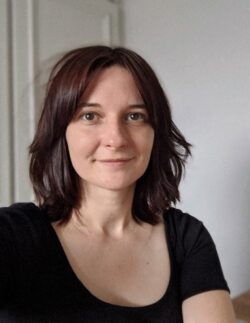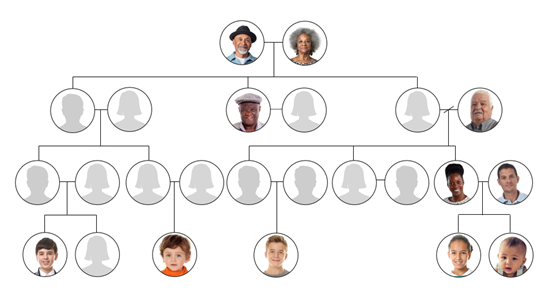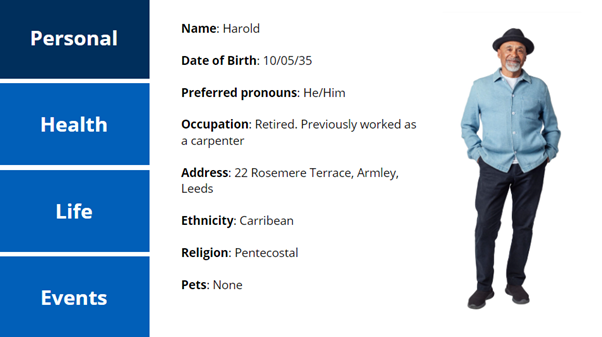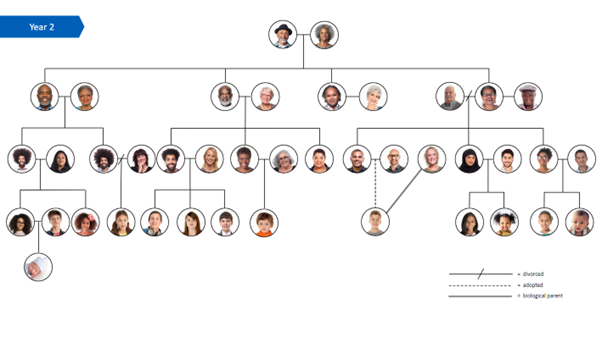Creating the Award-winning Baines Family Tree
As the end of my first semester as a learning technologist in the Faculty of Medicine and Health approached, I found myself in an unexpected position: sifting through hundreds of stock photographs to find a man of Caribbean descent in his mid-60s. This man was to be Maurice Baines, the last of forty family members whose pictures I’d chosen to form part of the Baines Family Tree, an interactive learning resource and recent winner of the 2023 Faculty and University-Wide Partnership Awards for Innovation.

Lisa Forbes Grant

Kate Philips
The resource was commissioned by Lisa Forbes Grant and Kate Philips in the School of Healthcare who came to our team with the idea for a resource offering students a wide range of information about a single four-generation family in June 2022. This was the first project assigned to me as a new starter in the Digital Education Enhancement Team in FMH. I didn’t know what to expect but was intrigued by the premise and inspired by the enthusiasm and ambition of the academics. I’d also begun training in Articulate Storyline—a learning design software, allowing for the complex navigation of highly interactive slides—which felt like the perfect fit for the project. Having gathered the initial information, I set to work.

The Baines Family Tree: Year 1 Prototype
It took some time for the design of the project to come into focus. I had a clear idea of the layout of the family tree from the outset, which I first sketched by hand and then digitised. How to convey the family information proved more of a challenge. The resource had to meet several needs: it had to present basic information for each family member, including their personal information, life situation, and health circumstances; it had to incorporate scenario-based information, simulating real-life situations; and it had to evolve over the course of three fictional years. With the support and advice of our senior learning technologist, Daniel Ward, and my fellow learning technologist, Charlotte Holmes, I was able to draft several character slides, using the bells and whistles of Storyline to make the information engaging and intuitive to access. The designs were all well-received, but it was a tab-based system, sharing the colour scheme of the NHS, that ultimately won out.

The Baines Family Tree: Harold Baines, tab-based slide
Thanks to smooth progress in the initial stages of the project, we realised that we could get an initial version of the resource out to the students earlier than expected. With this added motivation, I began populating the resource and finding images for my first characters: the elderly great-grandparents, Harold and Everine Baines. The storylines and circumstances of the family themselves were still being developed by Kate and Lisa at this stage, so we decided to focus on a limited number of members in an initial version of the tree that included approximately twenty people. In a matter of weeks, it was ready for the students to pilot and offer their feedback.
I think the Baines family tree is an excellent idea. I already feel like I’m getting stuck in and assured I am on the right course for me.
Student feedback
Very useful as I could focus on their issues and find out more information on their condition and use my theory and apply it to an actual scenario.
Student feedback
I enjoy the family tree. It’s a new type of learning I haven’t done before but seems a great resource to give us patient backgrounds to our assessment of patients in clinical skills.
Student feedback
Flash forward to the evening of 22 December, and I'd finally found our Maurice. Following excellent responses from the students to the first version of the tree, the family had now expanded to its full size, including the addition of a fifth generation in the form of baby Tommy. I’d also used the functionality of Storyline to incorporate a second-year version that would continue the dramatic narratives and diverse health and social situations of the characters. The two-year version has now been trialled with the students, eliciting more great feedback. I’m currently waiting to hear from Kate and Lisa about the fate of the Baines family in their third and final year.

The Baines Family Tree: Year 2
For now, the family tree continues to be used in innovative ways, meeting a wide range of teaching, learning, and assessment needs. As reported by Lisa and Kate, different characters have supported the application of theory surrounding different nursing concepts and conditions into practice. Engagement with the tree as a whole, meanwhile, has highlighted the relevance of hereditary health issues. The inclusion of scenarios, accompanied by social determinants of health, has also supported higher-level thinking, essential for the development of competent and critical-thinking healthcare professionals. So far, the family tree has been used across all fields of nursing and imbedded in all modules across year 1 and year 2, with year 3 modules soon to be included. The characters have also been used to inform assessments, with students being judged on their application of knowledge and understanding in relation to the nursing care of individuals within the family. Characters have even been simulated by actors in both clinical skills sessions and practical ward experiences, adding an extra layer of veracity to the scenarios. As a result, Kate and Lisa have been able to observe the students during sessions, approaching communication with the patients and applying knowledge learned through engagement with the resource.
Coming from a background in musical academia, this project has been the perfect introduction to the world of digital education, highlighting how digital technology can be used in innovative ways to enhance the teaching potential of staff and the learning experiences of students. We are incredibly proud as a team to have been recognised by our peers in the Partnership Awards. However, this is only the beginning for the resource, with plans for expansion in delivery; dissemination of our innovative practice via conference presentations and journal publications; and the development of multimedia resources and further simulation-based use of the family tree on the horizon.
